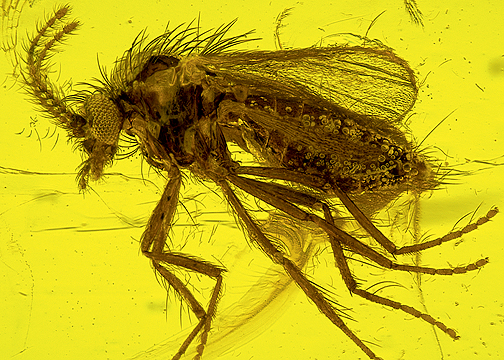Abstract
Biting midges (Ceratopogonidae) are a relatively well-studied family of nematocerous flies distributed worldwide, including 6,206 extant and 296 fossil species. To date, 1,146 extant and 32 fossil species in the genus Forcipomyia have been recorded in the world (Borkent & Dominiak, 2020). Biting midges of the subgenus Forcipomyia s. str. are indicative of forests because their larvae and pupae usually live under the bark of rotting trees (Szadziewski, 2018). The oldest records of the genus are from the Eocene. Forcipomyia are reported from early Eocene Fushun amber (one species; Hong, 1981; Stebner et al., 2016; Szadziewski, 2018; Krzemiński et al., 2019), early Eocene Cambay amber (unnamed, Stebner et al., 2017), middle Eocene Sakhalin amber (one species, Szadziewski & Sontag, 2013), Eocene Baltic amber from the Gulf of Gdańsk, Rovno and Bitterfeld (21 species; Szadziewski, 1988, Szadziewski, 1993, Sontag & Szadziewski, 2011), Miocene Dominican amber (10 species, Szadziewski & Grogan, 1998) and Miocene Mexican amber (unnamed, Szadziewski & Grogan, 1996).
References
Bouju, V. & Perrichot, V. (2020) A review of amber and copal occurrences in Africa and their paleontological significance. BSGF—Earth Sciences Bulletin, 2020, 191, 17. https://doi.org/10.1051/bsgf/2020018
Borkent, A. & Dominiak, P. (2020) Catalog of the biting midges of the World (Diptera: Ceratopogonidae). Zootaxa, 4787 (1), 377 pp. https://doi.org/10.11646/zootaxa.4787.1.1
DeMeillon, B. & Wirth, W.W. (1991) The genera and subgenera (excluding Culicoides) of the Afrotropical biting midges (Diptera: Ceratopogonidae). Annals of the Natal Museum, 32, 27–147.
Hong, Y.C. (1981) Eocene fossil Diptera in amber in Fushun coalfield [in Chinese, English summary]. Peking (= Beijing): Geological Publishing House, 166 pp.
Krzemiński, W., Blagoderov, V., Azar, D., Lukashevich, E., Szadziewski, R., Wedmann, S., Nel, A., Collomb, F.M., Waller, A. & Nicholson, D.B. (2019) True flies (Insecta: Diptera) from the late Eocene insect limestone (Bembridge Marls) of the Isle of Wight, England, UK. Earth and Environmental Science Transactions of the Royal Society of Edinburgh, 110 (3–4), 495–554. https://doi.org/10.1017/S1755691018000464
Lenz, F. (1934) 13a. Heleidae (Ceratopogonidae). In: E. Lindner (ed.), Die Fliegen der palaearktischen Region, 3, 95–133 (Lfg.78). Stuttgart.
Meigen, J.W. (1818) Systematische Beschreibung der bekannten europäischen zweiflügeligen Insekten. Vol. 1, xxxvi + 333 pp., pls. 1–11. Aachen. https://doi.org/10.5962/bhl.title.13731
Meunier, F. (1904) Monographie des Cecidomyidae, des Sciaridae, des Mycetophilidae et des Chironomidae de l’ambre de la Baltique (concl.). Annales de la Société Scientifique de Bruxelles (Mém.), 28, 93–275. https://doi.org/10.5962/bhl.title.8565
Newman, E. (1834) Attempted division of British insects into natural orders. Entomological Magazine, 2, 379–431.
Sontag, E. & Szadziewski, R. (2011) Biting midges (Diptera: Ceratopogonidae) in Eocene Baltic amber from the Rovno region (Ukraine). Polish Journal of Entomology, 80, 779–800. https://doi.org/10.2478/v10200-011-0058-4
Stebner, F., Szadziewski, R. & Wang, B. (2016) Biting midges (Diptera: Ceratopogonidae) in Fushun amber reveal further biotic links between Asia and Europe during the Eocene. Palaeontologia Electronica, 19 (3), 1–9. https://doi.org/10.26879/597
Stebner, F., Szadziewski, R., Singh, H., Gunkel, S. & Rust, J. (2017) Biting midges (Diptera Ceratopogonidae) from Cambay amber indicate that the Eocene fauna of the Indian subcontinent was not isolated. PLoS ONE, 12 (1), e0169144. https://doi.org/10.1371/journal.pone.0169144
Szadziewski, R. (1988) Biting midges (Diptera, Ceratopogonidae) from Baltic amber. Polskie Pismo Entomologiczne, 58, 3–283.
Szadziewski, R. (1993) Biting midges (Diptera, Ceratopogonidae) from Miocene Saxonian amber. Acta Zoologica Cracoviensia, 35, 603–656.
Szadziewski, R. (2018) Biting midges (Diptera: Ceratopogonidae) as indicators of biostratigraphy, ecological reconstructions and identification of amber deposits. Earth and Environmental Science Transactions of the Royal Society of Edinburgh, 107, 219–230. https://doi.org/10.1017/S1755691017000378
Szadziewski, R. & Grogan, W.L. (1996) Biting midges (Diptera: Ceratopogonidae) from Mexican amber. Polish Journal of Entomology, 65, 291–295.
Szadziewski, R. & Grogan, W.L. (1998) Biting midges from Dominican amber. IV. Species of the tribes Dasyheleini and Forcipomyiini (Diptera: Ceratopogonidae). Polish Journal of Entomology, 67, 255–290.
Szadziewski, R. & Sontag, E. (2013) A new species of Forcipomyia from Paleocene Sakhalin amber (Diptera: Ceratopogonidae). Polish Journal of Entomology, 82, 59–62. https://doi.org/10.2478/v10200-012-0023-x


